display OLDSMOBILE SILHOUETTE 2003 Owners Manual
[x] Cancel search | Manufacturer: OLDSMOBILE, Model Year: 2003, Model line: SILHOUETTE, Model: OLDSMOBILE SILHOUETTE 2003Pages: 466, PDF Size: 21.55 MB
Page 118 of 466

B (LOCK): This is the only position from which you
can remove the key. This position locks your ignition,
steering wheel and transaxle.
Notice: If your key seems stuck in LOCK and you
can’t turn
it, be sure you are using the correct key;
if
so, is it all the way in? If it is, then turn the
steering wheel left and right while you turn the key hard. Turn the key only with your hand. Using a
tool to force
it could break the key or the ignition
switch. If none
of these works, then your vehicle
needs service.
C (OFF): This position unlocks the ignition, steering
wheel and transaxle but, does not send power to
any accessories. Use this position
if your vehicle
must be pushed or towed, but never try
to push-start
your vehicle.
D (RUN): This is the position to which the switch returns
after you start your engine and release the ignition key.
This is the position for driving. Even when the engine is
not running, you can use RUN to operate your electrical
accessories and
to display some instrument panel
warning lights.
E (START): This position starts the engine. When the
engine starts, release the ignition key. The switch
will return to RUN for normal driving.
If the engine is not running, ACCESSORY and RUN
are positions that allow you to operate your electrical
accessories, such as the radio.
Retained Accessory Power (RAP)
With RAP, the power windows, power rear quarter
windows, audio system and the automatic level control
will continue to work up to
10 minutes after the
ignition key is turned to
OFF and none of the doors
are opened.
2-33
Page 179 of 466
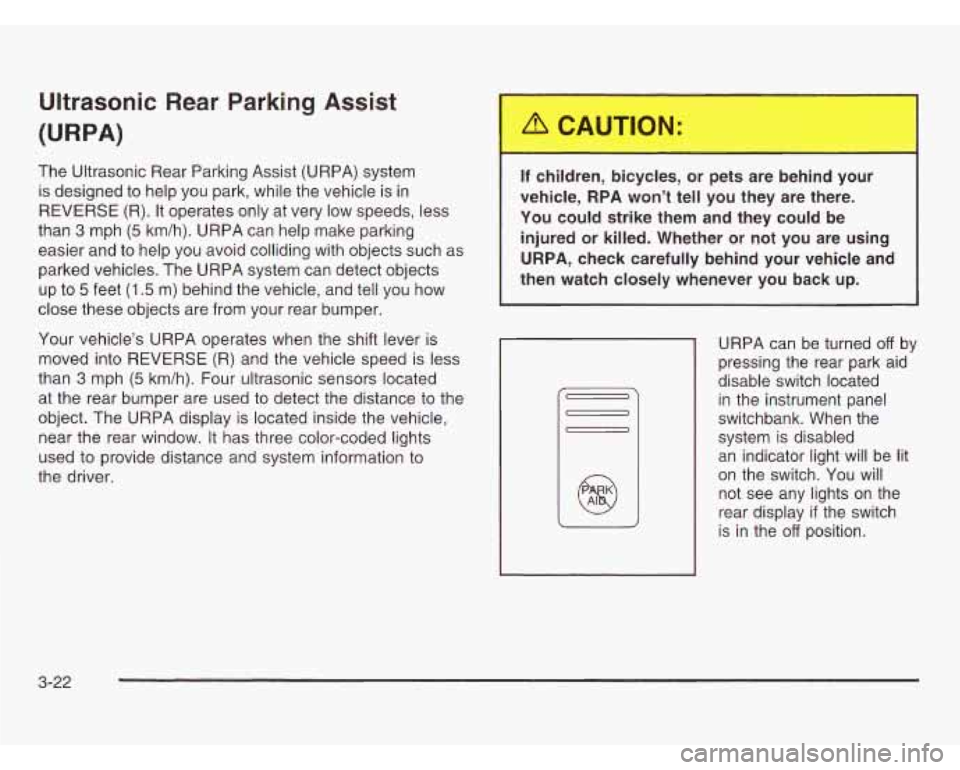
Ultrasonic Rear Parking Assist
(URPA)
The Ultrasonic Rear Parking Assist (URPA) system
is designed to help you park, while the vehicle is in
REVERSE (R). It operates only at very low speeds, less
than
3 mph (5 km/h). URPA can help make parking
easier and to help you avoid colliding with objects such as
parked vehicles. The URPA system can detect objects
up to
5 feet (1.5 m) behind the vehicle, and tell you how
close these objects are from your rear bumper.
Your vehicle’s URPA operates when the shift lever is
moved into REVERSE (R) and the vehicle speed is less
than
3 mph (5 km/h). Four ultrasonic sensors located
at the rear bumper are used to detect the distance to the
object. The URPA display is located inside the vehicle,
near the rear window. It has three color-coded lights
used to provide distance and system information to
the driver.
~~ children licj -.%s, or pets arc __ your
vehicle,
RPA won’t tell you they are there.
You could strike them and they could be
injured or killed. Whether or not you are using
URPA, check carefully behind your vehicle and
then watch closely whenever you back
up.
URPA can be turned off by
pressing the rear park aid
disable switch located
in the instrument panel
switchbank. When the
system is disabled
an indicator light will be lit
on the switch. You will
not see any lights on the
rear display
if the switch
is in the
off position.
3-22
Page 180 of 466

How the System Works
Unless disabled, the URPA will turn on automatically
when the shift lever is moved into REVERSE (R).
When the system turns on, the three lights on the
display will illuminate for one and a half seconds to let
you know that the system is working. If your vehicle
is moving in REVERSE (R) at a speed greater
than
3 mph (5 km/h), the red light will flash to remind
you that the system does not work at speed greater than
3 mph (5 km/h).
If an object is detected at a REVERSE (R) speed of
less than
3 mph (5 km/h), one of the following will occur:
Description
1.5 m 5 ft.
amber light Metric
English I - I
ambedamber lights
0.5 m
continuous chime 1.0 m 40 in.
ambedambedred lights
& 20 in.
1 ambedambedred lights
chime I I
A chime will sound the first time an object is detected
between
20 inches (0.5 m) and 5 feet (1.5 m) away.
flashing
& continuous I 0.3 m
L
When
the System Does Not Seem to
Work Properly
The light may flash red when the vehicle is in
REVERSE (R) if the ultrasonic sensors are not kept
clean.
So be sure to keep your rear bumper free of mud,
dirt, snow, ice and slush. Other conditions that may
affect system performance include things like the
vibrations from a jackhammer or the compression of
air brakes on a very large truck. If after cleaning
the rear bumper and then driving forward at least
15 mph
(25 km/h), the display continues to flash red,
see your dealer.
If a trailer was attached to your vehicle, or a bicycle or
an object was on the back of, or hanging out of your
liftgate during your last drive cycle, the light may
also flash red. The light will continue to flash whenever
in REVERSE (R) until your vehicle is driven forward
at least 15 mph (25 km/h) without any obstructions
behind the vehicle.
For cleaning instructions, see
Cleaning the Outside of .I- I#-#-. I UUI vellrdc oli p/ayt. a-rv. r
URPA cannot detect objects that are above liftgate level.
In order for the rear sensors to recognize an object,
it must be within detection range behind the vehicle.
3-23
Page 192 of 466
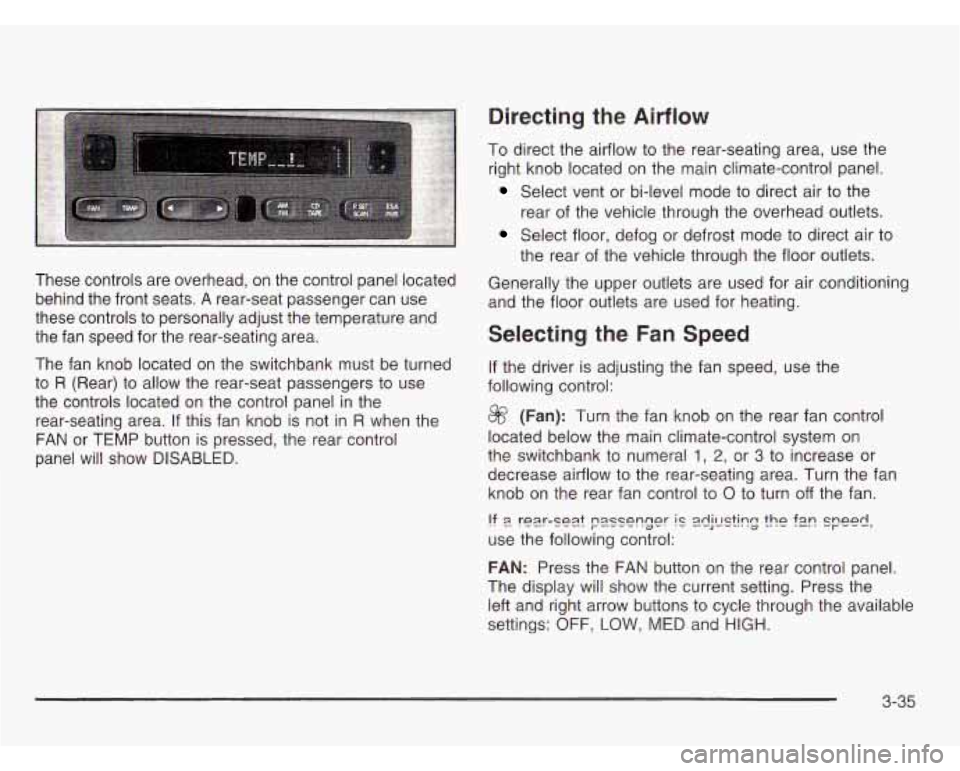
Directing the Airflow
These controls are overhead, on the control panel located
behind the front seats.
A rear-seat passenger can use
these controls to personally adjust the temperature and
the fan speed for the rear-seating area.
The fan knob located on the switchbank must be turned
to
R (Rear) to allow the rear-seat passengers to use
the controls located on the control panel in the
rear-seating area.
If this fan knob is not in R when the
FAN or TEMP button is pressed, the rear control
panel will show
DISABLED.
To direct the airflow to the rear-seating area, use the
right knob located on the main climate-control panel.
Select vent or bi-level mode to direct air to the
rear of the vehicle through the overhead outlets.
Select floor, defog or defrost mode to direct air to
the rear of the vehicle through the floor outlets.
Generally the upper outlets are used for air conditioning
and the floor outlets are used for heating.
Selecting the Fan Speed
If the driver is adjusting the fan speed, use the
following control:
@ (Fan): Turn the fan knob on the rear fan control
located below the main climate-control system on
the switchbank to numeral
1, 2, or 3 to increase or
decrease airflow to the rear-seating area. Turn the fan
knob on the rear fan control to
0 to turn off the fan.
!? 9 rear-se2.t passenger IC 2dj!E?k?g the f2n speed,
use the following control:
FAN: Press the FAN button on the rear control panel.
The display will show the current setting. Press the
left and right arrow buttons to cycle through the available
settings:
OFF, LOW, MED and HIGH.
3-35
Page 198 of 466
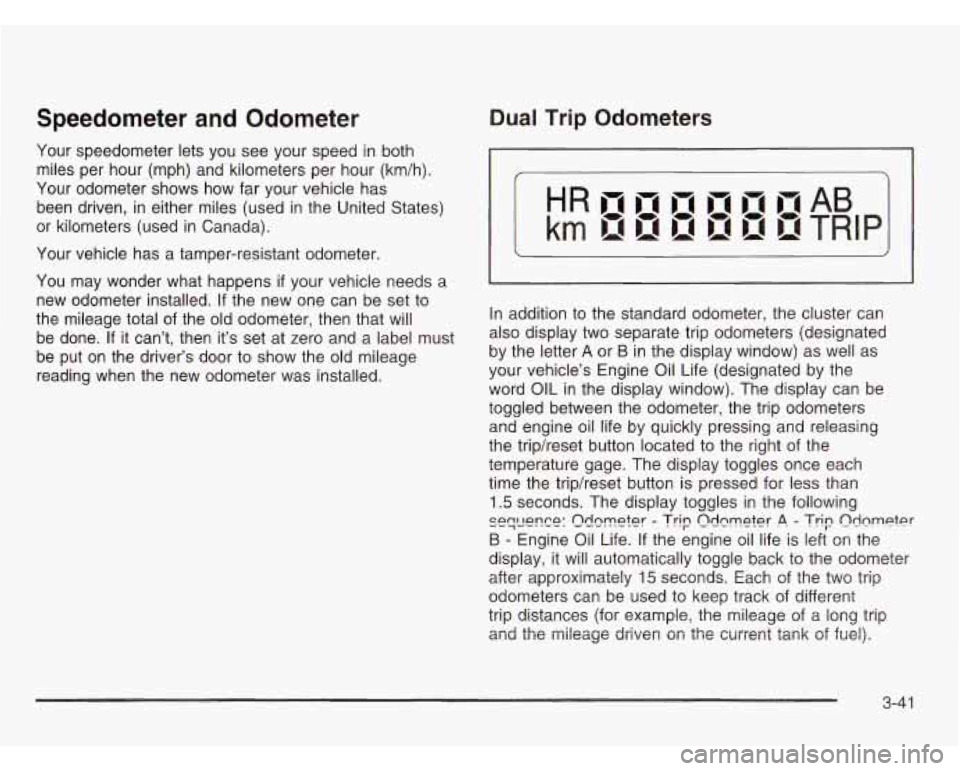
Speedometer and Odometer
Your speedometer lets you see your speed in both
miles per hour (mph) and kilometers per hour (km/h).
Your odometer shows how far your vehicle has
been driven, in either miles (used in the United States)
or kilometers (used in Canada).
Your vehicle has a tamper-resistant odometer.
You may wonder what happens
if your vehicle needs a
new odometer installed.
If the new one can be set to
the mileage total of the old odometer, then that will
be done.
If it can’t, then it’s set at zero and a label must
be put on the driver’s door to show the old mileage
reading when the new odometer was installed.
Dual Trip Odometers
In addition to the standard odometer, the cluster can
also display two separate trip odometers (designated
by the letter
A or B in the display window) as well as
your vehicle’s Engine Oil Life (designated by the
word
OIL in the display window). The display can be
toggled between the odometer, the trip odometers
and engine oil life by quickly pressing and releasing
the tripheset button located to the right of the
temperature gage. The display toggles once each
time the tripheset button is pressed for less than
1.5 seconds. The display toggles in the following
si?qwn~e: Q!km&r - Trip Qdnm~t~r .A. - Trip n&m@er
B - Engine Oil Life. If the engine oil life is left on the
display, it will automatically toggle back to the odometer
after approximately
15 seconds. Each of the two trip
odometers can be used to keep track of different
trip distances (for example, the mileage of
a long trip
and the mileage diiileii oi-i the cui-i-ei-it tank of fuel).
3-4 1
Page 199 of 466
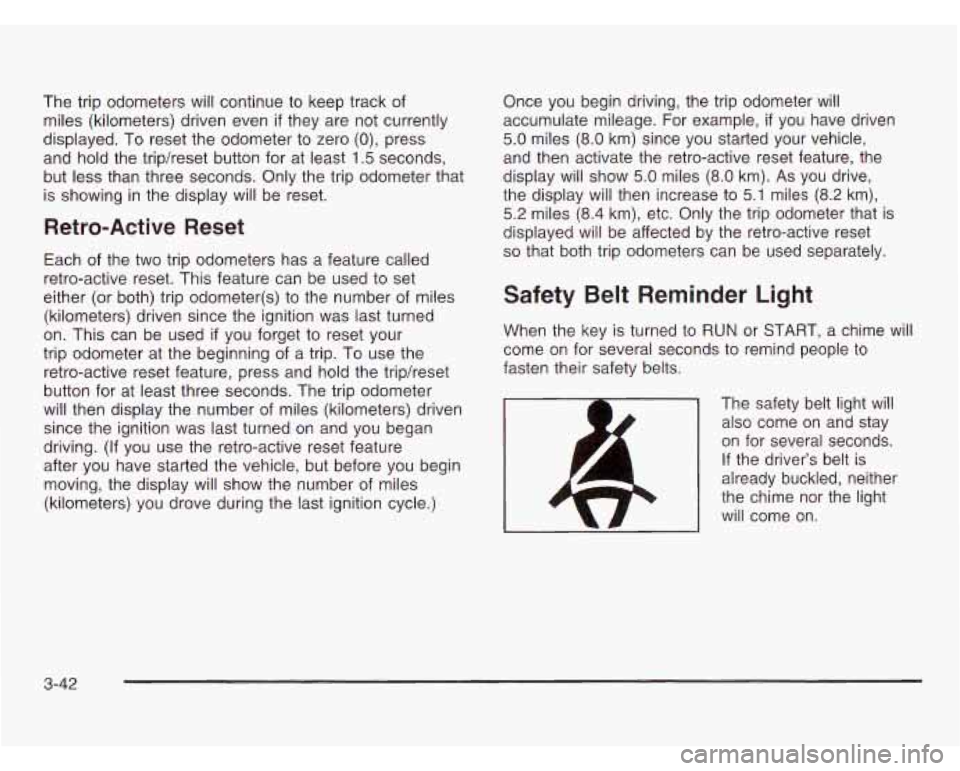
The trip odometers will continue to keep track of
miles (kilometers) driven even
if they are not currently
displayed. To reset the odometer to zero
(0), press
and hold the tripheset button for at least
1.5 seconds,
but less than three seconds. Only the trip odometer that
is showing in the display will be reset.
Retro-Active Reset
Each of the two trip odometers has a feature callea
retro-active reset. This feature can be used to set
either (or both) trip odometer(s) to the number of miles
(kilometers) driven since the ignition was last turned
on. This can be used
if you forget to reset your
trip odometer at the beginning of a trip. To use the
retro-active reset feature, press and hold the tripheset
button for at least three seconds. The trip odometer
will then display the number of miles (kilometers) driven
since the ignition was last turned on and you began
driving. (If you use the retro-active reset feature
after you have started the vehicle, but before you begin
moving, the display will show the number of miles
(kilometers) you drove during the last ignition cycle.) Once you
begin driving, the trip odometer will
accumulate mileage. For example,
if you have driven
5.0 miles (8.0 km) since you started your vehicle,
and then activate the retro-active reset feature, the
display will show
5.0 miles (8.0 km). As you drive,
the display will then increase to
5.1 miles (8.2 km),
5.2 miles (8.4 km), etc. Only the trip odometer that is
displayed will be affected by the retro-active reset
so that both trip odometers can be used separately.
Safety Belt Reminder Light
When the key is turned to RUN or START, a chime will
come on for several seconds to remind people to
fasten their safety belts.
The safety belt light will also come on and stay
on for several seconds.
If the driver’s belt is
already buckled, neither
the chime nor the light
will come on.
3-42
Page 209 of 466
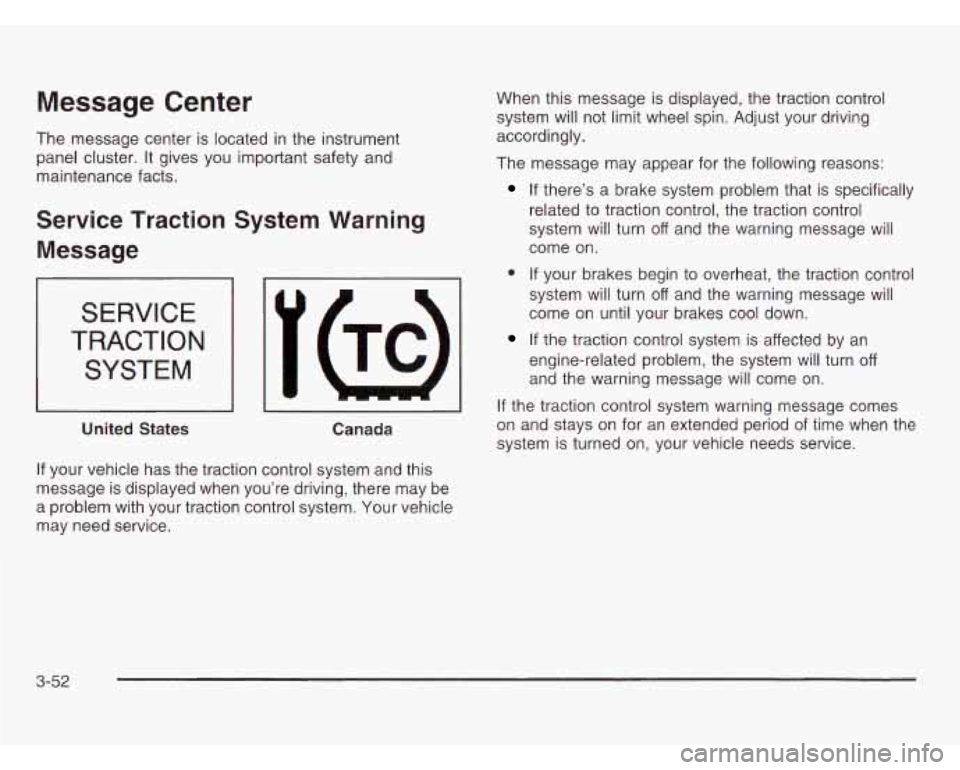
Message Center
The message center is located in the instrument
panel cluster.
It gives you important safety and
maintenance facts.
Service Traction System Warning
Message
SERVICE
TRACTION
SYSTEM
United States
I I
Canada When
this message is displayed, the traction control
system will not limit wheel spin. Adjust your driving
accordingly.
The message may appear for the following reasons:
If there’s a brake system problem that is specifically
related to traction control, the traction control
system will turn
off and the warning message will
come on.
e If your brakes begin to overheat, the traction control
system will turn
off and the warning message will
come on until your brakes cool down.
engine-related problem, the system will turn off
and the warning message will come on.
If the traction control system warning message comes
on and stays on for an extended period of time when the
system is turned on, your vehicle needs service.
If the traction control system is affected by an
If your vehicle has the traction control system and this
message is displayed when you’re driving, there may be
a problem with your traction control system. Your vehicle
may need service.
3-52
Page 217 of 466

Driver Information Center (DIC)
Your vehicle may have a DIC. If it does, the DIC will show
information about the vehicle and the surroundings.
E/M (English/Metric Button): You can change the
display to a metric or English reading at any time
by pressing E/M.
MODE: Press this button to cycle through three modes
of operation
- off, compass/temperature and trip
computer mode.
Off:
No driver information is displayed in this mode
of operation.
Compass/Temperature Mode: One of eight compass
readings and the outside temperature are displayed.
If the temperature is below 38°F (3"C), the temperature
reading will toggle between displaying the outside
temperature and the word ICE for two minutes.
Trip Computer
Mode: In the trip computer mode,
pressing the MODE button cycles through the five
displays. Press the MODE button after the last trip
computer display to return the DIC to the OFF mode.
See "Trip Computer" later in this section for more
information.
3-60
Page 218 of 466

Compass Variance
Compass variance is the difference between magnetic
north and geographic north. In some areas of the
country, the difference is great enough to cause the
compass to give false readings. If this occurs, the
compass variance must be set.
Setting the Variance
t ('7
Turn the ignition on and cycle the DIC to the compass/
temperature mode. Press both the
E/M and MODE
buttons simultaneously for approximately five seconds.
The last entered variance zone number will be displayed.
Press the E/M button until the proper variance number,
as shown on the map, is showing. Press the MODE
button to set the new variance zone and resume normal
operation.
The display will show all the display segments briefly to
acknowledge the change
in the zone number.
Automatic Compass Calibration
The compass is self-calibrating, which eliminates the
need to manually set the compass. When the vehicle
is new, the calibration process may not be complete.
In these cases the calibration symbol C will be displayed
where the compass reading is normally displayed.
To calibrate the compass, in an area free from large
metal objects, make three
360" turns. The calibration
symbol will turn
off and the compass reading will
be displayed.
3-6 1
Page 219 of 466
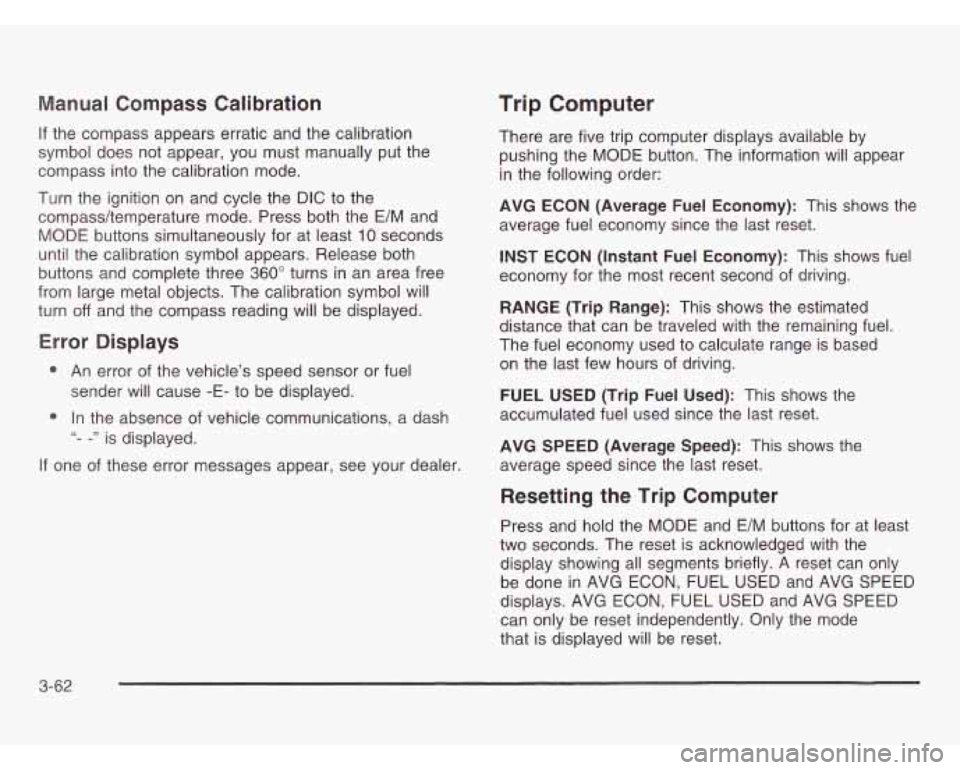
Manual Compass Calibration
If the compass appears erratic and the calibration
symbol does not appear, you must manually put the
compass into the calibration mode.
Turn the ignition on and cycle the DIC to the
compass/temperature mode. Press both the
E/M and
MODE buttons simultaneously for at least
10 seconds
until the calibration symbol appears. Release both
buttons and complete three
360" turns in an area free
from large metal objects. The calibration symbol will
turn
off and the compass reading will be displayed.
Error Displays
0 An error of the vehicle's speed sensor or fuel
0 In the absence of vehicle communications, a dash
sender
will cause
-E- to be displayed.
"- -" is displayed.
If one of these error messages appear, see your dealer.
Trip Computer
There are five trip computer displays available by
pushing the MODE button. The information will appear
in the following order:
AVG ECON (Average Fuel Economy): This shows the
average fuel economy since the last reset.
INST ECON (Instant Fuel Economy): This shows fuel
economy for the most recent second of driving.
RANGE (Trip Range): This shows the estimated
distance that can be traveled with the remaining fuel.
The fuel economy used to calculate range is based
on the last few hours of driving.
FUEL USED (Trip Fuel Used): This shows the
accumulated fuel used since the last reset.
AVG SPEED (Average Speed): This shows the
average speed since the last reset.
Resetting the Trip Computer
Press and hold the MODE and E/M buttons for at least
two seconds. The reset is acknowledged with the
display showing all segments briefly. A reset can only
be done in AVG ECON, FUEL USED and AVG SPEED
displays. AVG ECON, FUEL USED and AVG SPEED
can only be reset independently. Only the mode
that is displayed will be reset.
3-62